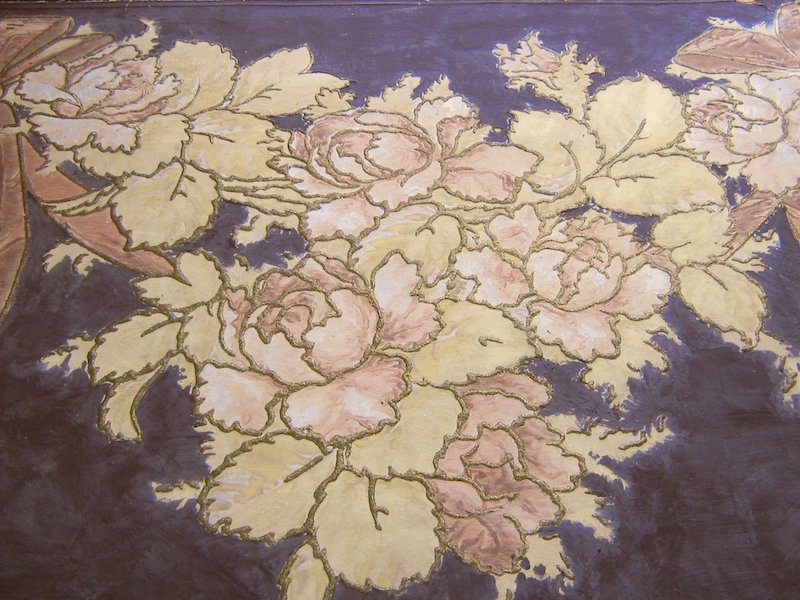When the Kelley House began its journey from a private residence to a museum in 1975, its interior walls were covered with sagging strips of wallpaper, the adhesive having deteriorated almost completely. As renovations went forward, samples of these vintage wallcoverings were preserved in the museum’s archives. They had stylized floral patterns in metallic gold and silver, burgundy, gold and pale yellow, and deep burgundy, a color palette that has been continued through subsequent facelifts.
Rolls of machine-made wallpaper were first produced in Delaware in 1817; by the 1880s, further manufacturing advancements, which included the use of wood pulp and machine printing, brought the price of paper wall coverings low enough that it became commonplace to enliven the interiors of buildings with them. Previous to that, the walls of middle- or working-class homes were usually whitewashed, and only the wealthy could afford papered, plastered, or painted walls. Wood paneling was also expensive, but in Mendocino, where wood was plentiful and less costly, paneling was a good option for bringing style or durability to the lower parts of walls. In the Kelley House kitchen-dining room, the original beaded board wainscoting is intact.

McCornack Hospital Wallpaper, c. 1880s. Hand-painted wallpaper from the McCornack Hospital, once located in the large white house on the southeast corner of Howard and Ukiah Streets in Mendocino (now Blue Door Inn). The wallpaper, probably silkscreened onto thick paper, was adhered onto a linen backing and then glued over the existing wallpaper. The design depicts pink peonies with light green leaves and ribbons that are outlined with a raised gold glitter.
The walls of homes like the Kelley’s were built of several layers. They were first covered with wooden planks nailed to upright studs, which were of variable dimensions and sometimes set apart at greater distances than what we typically find today. This layer of boards would do much to strengthen the wall structure but were not meant to see the light of day. Instead, they would be covered with finer grades of tongue & groove boards, beadboard, or wood paneling. But how to create a smooth surface with all those cracks between the strips of wood? The answer is cloth. By the time Mendocino’s buildings were going up, wallpapers were pasted onto loosely woven, light-weight cotton or linen before they were hung to make the wall appear as smooth as possible.
As time went on and fashions changed, new papers were put right on top of the older ones. Examples of this wallpaper “sandwich” have been preserved in the museum archives. Of particular interest are the ceiling papers that have a light background and stylized metallic silver or gold patterns. These would have created a soft, reflective surface to brighten interiors on dim, foggy days.
It wasn’t only well-to-do merchants like William Kelley who lined the walls of their homes with cloth and wallpaper. According to the 1883 Sanborn Insurance map (courtesy of David J. Russell, who years ago photographed the copy held by the Presbyterian Church), there were at least 56 structures throughout town that carried the symbol used for “Cloth-Lined” walls: CL inside a circle. Almost all were dwellings, except three saloons— the Lisbon House on Ukiah Street, Duncan Walker’s Saloon on Main (which would become the now-gone Alhambra Hotel), and a small joint on Main Street where Flow Restaurant is today. Of the dwellings, two were labeled “Chinese” and were on property the Kelley family owned immediately east of the MacCallum House, where Corners of the Mouth is today.
If you wonder why a fire insurance mapping company would take the time to call out buildings with wallpaper, wooden walls lined with extremely flammable cloth could quickly catch fire, which would spread throughout the building, resulting in considerable loss. Luckily, the Kelley House has only caught fire once (that we know of). In 1971, a smoldering fire in the dining room’s brick fireplace was quickly extinguished by the Mendocino Volunteer Fire Department, but not before causing some damage to the room’s interior and exterior walls and windows.
Remnants of cloth-lined walls, as well as other interesting objects from the Kelley House collections, are on display in the new 50th Anniversary exhibit, Kelley House Museum: Building a Home.
The Kelley House Museum is open from 11AM to 3PM Thursday through Monday. If you have a question for the curator, reach out to curator@kelleyhousemuseum.org to make an appointment. Walking tours of the historic district depart from the Kelley House regularly.